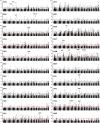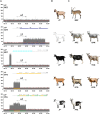Selection signatures in goats reveal copy number variants underlying breed-defining coat color phenotypes
- PMID: 31841508
- PMCID: PMC6936872
- DOI: 10.1371/journal.pgen.1008536
Selection signatures in goats reveal copy number variants underlying breed-defining coat color phenotypes
Abstract
Domestication and human selection have formed diverse goat breeds with characteristic phenotypes. This process correlated with the fixation of causative genetic variants controlling breed-specific traits within regions of reduced genetic diversity, so called selection signatures or selective sweeps. Using whole genome sequencing of DNA pools (pool-seq) from 20 genetically diverse modern goat breeds and bezoars, we identified 2,239 putative selection signatures. In two Pakistani goat breeds, Pak Angora and Barbari, we found selection signatures in a region harboring KIT, a gene involved in melanoblast development, migration, and survival. The search for candidate causative variants responsible for these selective sweeps revealed two different copy number variants (CNVs) downstream of KIT that were exclusively present in white Pak Angora and white-spotted Barbari goats. Several Swiss goat breeds selected for specific coat colors showed selection signatures at the ASIP locus encoding the agouti signaling protein. Analysis of these selective sweeps revealed four different CNVs associated with the white or tan (AWt), Swiss markings (Asm), badgerface (Ab), and the newly proposed peacock (Apc) allele. RNA-seq analyses on skin samples from goats with the different CNV alleles suggest that the identified structural variants lead to an altered expression of ASIP between eumelanistic and pheomelanistic body areas. Our study yields novel insights into the genetic control of pigmentation by identifying six functionally relevant CNVs. It illustrates how structural changes of the genome have contributed to phenotypic evolution in domestic goats.
Conflict of interest statement
The authors have declared that no competing interests exist.
Figures




References
-
- FAO. The Second Report on the State of the World’s Animal Genetic Resources for Food and Agriculture, edited by B.D. Scherf & D. Pilling. FAO Commission on Genetic Resources for Food and Agriculture Assessments. Rome 2015. (http://www.fao.org/3/a-i4787e/index.html)

